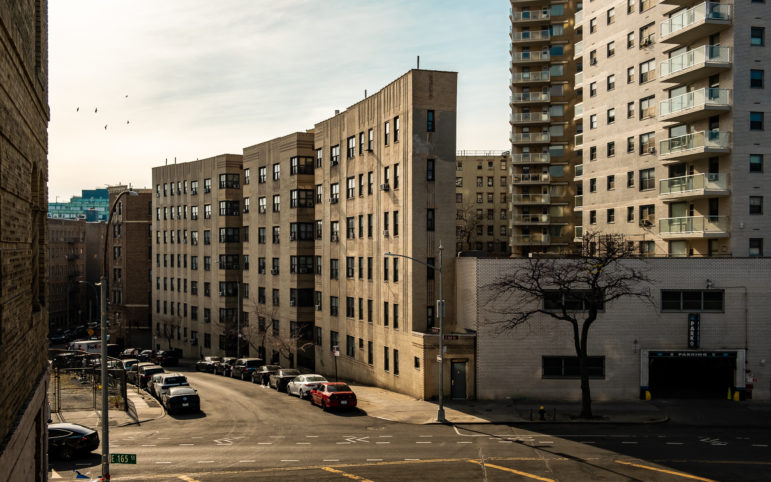Local Law 97, passed in 2019, requires buildings to lower emissions beginning in 2024. Property owners who fail to comply will face penalties calculated based upon how much their buildings’ emissions exceed the city’s benchmarks—what a new lawsuit decries as “draconian.”

Adi Talwar
Apartment buildings near Carroll Place and East 165th street in the Bronx.Building owners and managers are taking the city to court over a local law to decarbonize buildings and impose penalties based on carbon emissions.
The lawsuit, first reported by Crain’s New York, was filed Thursday in New York Supreme Court on behalf of Glen Oaks Village Owners, 9-11 Maiden LLC, and Bay Terrace Cooperative Section I. The complaint names New York City and the Department of Buildings as defendants.
The complaint, forwarded to City Limits by the law office representing the defendants, alleges that the city’s key emissions law is “ill conceived and unconstitutional” at the expense of building owners, landlords and shareholders. It calls the penalties written into the law “draconian.”
Local Law 97, passed in 2019, requires buildings over 25,000 square feet to lower emissions beginning in 2024, reaching a reduction of 40 percent in 2030 and 80 percent in 2050. Owners who fail to comply will face penalties based on how much their buildings’ emissions exceed the city’s benchmarks.
READ MORE: Progress and Delays in Putting Milestone Emissions Law into Action
The complaint claims that the law is preempted by the Climate Leadership and Community Protection Act, the state’s aggressive climate legislation also passed in 2019. “The CLCPA sets ambitious targets for the reduction of greenhouse gas emissions statewide and lays out a clear and all-encompassing plan by which New York State will implement these goals over the next several decades. It therefore preempts the field and leaves no room for localities to legislate in this area,” the complaint reads.
It also criticizes the calculation of penalties and the short timeframe for building owners to become compliant. Furthermore, it claims that it disproportionately targets buildings in densely populated areas and with longer hours of operation as well as buildings that by their nature use more power, including grocery stores, laundromats and restaurants.
Since taking office in January, City Comptroller Brad Lander has been vocal in his support for Local Law 97 and the need for the mayor’s office to fund and promote regulation of the legislation. The office would not comment on the pending lawsuit, but Louise Yeung, the comptroller’s chief climate officer, noted the office’s commitment to retrofitting buildings.
“The city has provided various resources to educating owners on how to convert buildings, and we support proactively ramping up these programs to work towards our collective emissions reduction by 2050,” Yeung told City Limits.
Environmental advocates claim the lawsuit and overall resistance from building owners is merely an attempt to skirt regulation.
“There’s a set of regressive landlords that are delaying upgrading their buildings because they hope [and] think that the Adams’ administration is going to let them off the hook,” said Pete Sikora, climate & inequality campaigns director of New York Communities for Change.
Sikora also took issue with the suit’s claim that the local law conflicts with New York State’s CLCPA, noting other city legislation aimed at reducing emissions.
“The entire body of laws that regulate fuel use, including the city gas ban in new construction and bans on certain types of high-polluting fuels, all of these help the state achieve the targets it’s set for itself under the CLCPA. But [the] CLCPA does not preempt local decisions to reduce pollution,” he said. “That’s simply absurd.”
Others say it’s more complicated.
Bob Friedrich, president of the first named plaintiff in the suit, Glen Oaks Village, which houses 3,000 residents in 134 buildings, has been vocal in public meetings about his opposition to the law as it is written. On April 13, he testified at a committee hearing on Local Law 97, calling the measure financially burdening.
“The New York City Council has imposed crippling financial costs and penalties on our families,” said Friedrich, in the hearing. “The Climate Mobilization Act requires us to undertake costly retrofitting of our heating and hot water systems regardless of our ability to pay and regardless of need.”
He explained that a study of the Glen Oaks heating plan estimated it would cost $17–$20 million to retrofit the boilers. Even with those improvements, he added, the algorithm would impose a fine of more than $800,000 a year. The boiler replacements would require each family to pay $7,200 on top of a 5 percent increase in maintenance fees, he said.
“This is insanity,” he added.
In New York, residential buildings emit more than 10 million metric tons of carbon dioxide a year, making them the city’s biggest source of pollution. In a recent report by the American Lung Association, The Bronx, Manhattan and Queens received “failing” grades for their high levels of ozone pollution—which is linked to vehicles and fossil fuels burning in buildings and power plants. Meanwhile, a new dashboard by the comptroller’s office shows the city is still far from the targets of greenhouse gas emission reductions required by the CLCPA by 2050.

Adi Talwar
Friday evening traffic heading west on 42nd Street between 5th and 6th Avenues in Manhattan.
Rohit Aggarwala, the city’s chief climate officer and commissioner of the Department of Environmental Protection (DEP), has spoken in favor of being lenient with building owners during the transition to Local Law 97’s full rollout. “We need to understand the challenge of building space and undertaking the work that needs to be done, and we need to do everything we can to help them,” Aggarwala said during a more than four-hour City Council committee meeting about the law in April.
The Department of Buildings offers free personalized guidance for building owners to make energy updates with retrofit and sustainability experts through the NYC Accelerator Program. The program has already served more than 9,000 buildings, according to the agency.
“In NYC, our buildings are the largest emitter of the greenhouse gasses that contribute to climate change, and we are committed to fully enforcing Local Law 97,” said Andrew Rudansky, DOB press secretary, in a statement to City Limits. The agency will review the lawsuit when it has been served, he added.
This legal measure is not the first time opponents have sought to stop or delay enforcement of a key city environmental law. In 2020, a statewide measure to effectively ban plastic bags was challenged in court by plastic bag manufacturer Poly-Pak Industries, the Bodega and Small Business Association, a Bronx grocery store and two grocery store owners. A State Supreme Court judge later upheld the Bag Waste Reduction Law, allowing for enforcement to begin in mid-October, about seven months later than the Department of Environment Conservation originally anticipated.
READ MORE: Plastic Bags Still Ubiquitous in NYC Shops, Months After Enforcement of Ban Began
Sikora said he’s heartened that the DOB seems committed to forging ahead as planned.
“That’s the kind of message that the administration should be putting out,” he said. “That this is a law; the law is reasonable. It’s necessary. It creates jobs, saves lives and reduces pollution. And the city is providing loads of resources for building owners to help them comply.”
05.18.2022 – Complaint, Loc… by Jeanmarie Evelly
Liz Donovan is a Report for America corps member.









